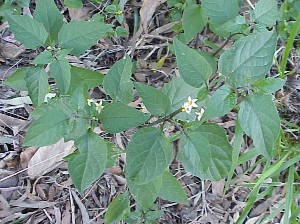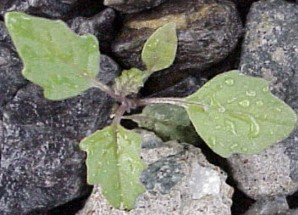Scientific name: Solanum americanum Miller
Synonyms: Solanum nodiflorum Jacq.; S. nodiflorum subsp. nutans R Henderson; S. nigrum auct. non L., Benth; S. americanum var. nodiflorum (Jacq.) EdmondsCommon name: Glossy nightshadeFamily: SolanaceaeOrigin:Cosmopolitan weed although the taxon Solanum americanum var. nodiflorum is thought to be native to Australia. Habit:Annual or short-lived perennial herb that is usually erect, growing to 1.25 m tall. Habitat:Common weed of untended areas near habitation. General description:Stems and leavesPlants are hairless or only sparsely hairy. The leaves have stalks (petioles) 1-9 cm long and oval or egg-shaped leaf blades (2-14 x 1-8 cm) tapering to a point at the tip. The margins of the leaves are entire or slightly lobed.Flowers and fruitThe flowers are small (8-9 mm across), white and star-shaped, with five petals and a yellow central cone. Flowers are borne in stalked clusters of 4-8 flowers. Flowering occurs from autumn to spring. The fruits are globular, shiny purplish black when ripe (although sometimes remaining green) and 6-9 mm in diameter. The fruit are borne in a relatively upright position with relatively large sepals that are bent downward (ie. reflexed).Distinguishing features:Herb growing to 1.25 m tall, with mostly hairless leaves that are arranged alternately on the stem. Flowers are small, white, star-like and borne on individual stalks. Fruits are glossy green, usually turning black as they mature, and are 6-9 mm in diameter. Very similar to Solanum nigrum (blackberry nightshade). However, this species has dull fruit that are borne pointing downward, with smaller outward pointing sepals. Noxious status:Not noxious. Sources:Kleinschmidt, H.E., Holland, A. and Simpson, P. (1996). Suburban Weeds. 3rd Edition. Department of Primary Industries, Brisbane. Stanley, T.E. and Ross, E.M. (1983-1989). Flora of South-eastern Queensland. Volume 2. Department of Primary Industries, Brisbane. Wilson, B.J., Hawton, D. and Duff, A.A. (1995). Crop Weeds of northern Australia: identification at seedling and mature stages. Queensland Department of Primary Industries, Brisbane. |
Brisbane
St Lucia, QLD 4072
+61 7 3365 1111
© 2009 The University of Queensland


